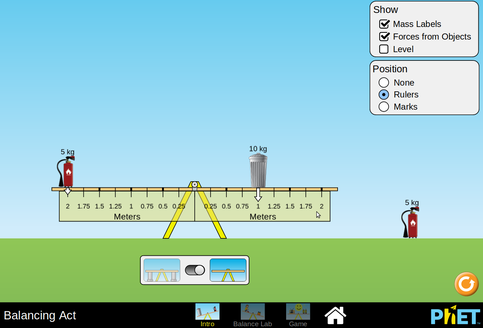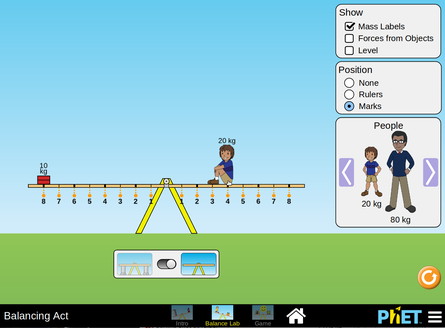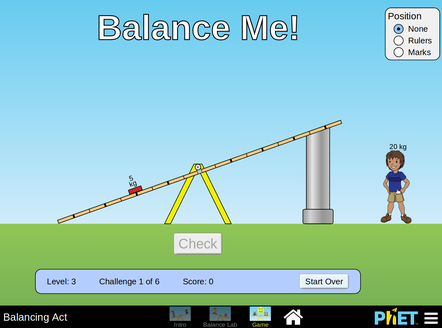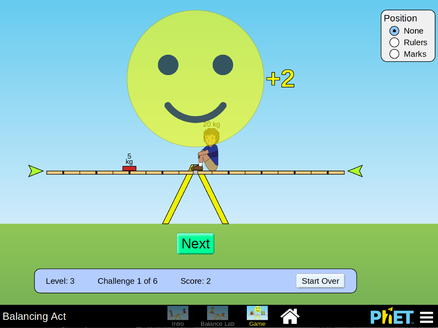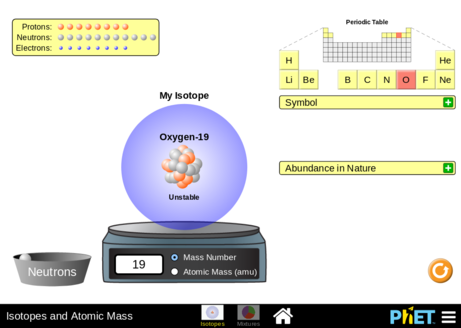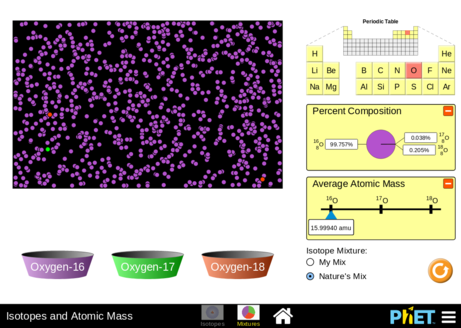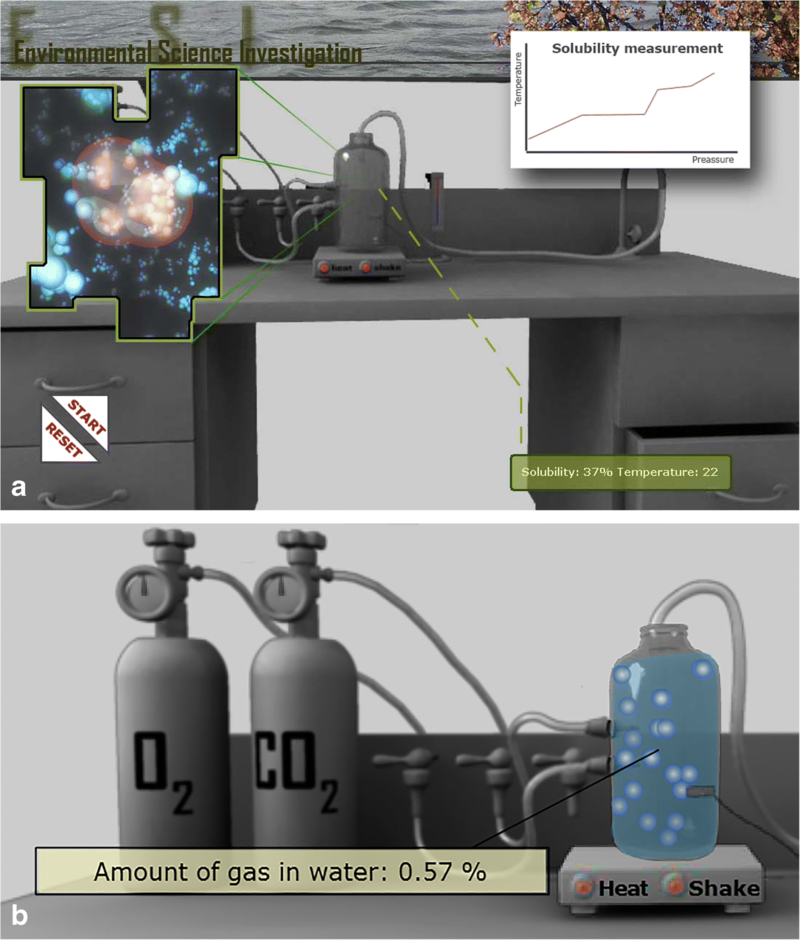Science simulation: Difference between revisions
| Line 86: | Line 86: | ||
The gas laboratory is a web-based environment for environmental science investigation. More precisely, as explained in the [http://esi.stanford.edu/about.htm about ESI] page, {{quotation|text=the main learning objective with this site is to spread knowledge on relations between environmental change and conditions for life. The ESI site describes and investigates the problem of declining salmon populations in the Fraser River, Canada which exemplifies an observed phenomenon where global warming is thought to play a major role.}}. The web site contains ten 30-60 minute activities that can be used in any order, but for best learning outcomes, it is recommended to do all activities from the first to the last. Most activities engage students in reading or looking at a multimedia resource and there is only one included simulation. | The gas laboratory is a web-based environment for environmental science investigation. More precisely, as explained in the [http://esi.stanford.edu/about.htm about ESI] page, {{quotation|text=the main learning objective with this site is to spread knowledge on relations between environmental change and conditions for life. The ESI site describes and investigates the problem of declining salmon populations in the Fraser River, Canada which exemplifies an observed phenomenon where global warming is thought to play a major role.}}. The web site contains ten 30-60 minute activities that can be used in any order, but for best learning outcomes, it is recommended to do all activities from the first to the last. Most activities engage students in reading or looking at a multimedia resource and there is only one included simulation. | ||
In the case of the gas laboratory, most learning activities are centered around reading and answering questions. Smaller simulations are a key elements in central activities. | In the case of the gas laboratory, most learning activities are centered around reading and answering questions. Smaller simulations are a key elements in central activities. More precisely, {{quotation|the functions of the Gas Laboratory included three laboratory tests investigating the solubility of gases in water.}} <ref name="waestberg2019"/>. The simulated laboratory mimicked a real world environment with semi-realistic workbench details. As Stahre Wästberg et al. <ref name="waestberg2019"/> notice, {{quotation|text=In the Gas Laboratory, neither visual realism nor complex interaction was actually required. The intent of the laboratory was to let students observe the amount of gas bubbles when changing three physical parameters (temperature, pressure and salinity), and to have them discuss and interpret what these gas bubbles actually meant.}}. They add that {{quotation|text=Research within visualisation clearly suggests that in many circumstances a stylised image is more efficient and easier to understand than one with a higher degree of realism and detail (Ryan and Schwartz 1956) <ref> Ryan, T. A., & Schwartz, C. B. (1956). Speed of perception as a function of mode of representation. American Journal of Psychology, 69, 60–69.</ref>. The evaluation of the Gas Laboratory indicates that the students did not request a more realistic representation of the laboratory environment; the students’ concern was rather how to interpret the amount of bubbles in different stages of the experiment.}} | ||
Below we show a few screenshots published by Wästberg et al. (2019) <ref name="waestberg2019">Stahre Wästberg, B., Eriksson, T., Karlsson, G., Sunnerstam, M., Axelsson, M., & Billger, M. (2019). Design considerations for virtual laboratories: A comparative study of two virtual laboratories for learning about gas solubility and colour appearance. Education and Information Technologies, 24(3), 2059–2080. <nowiki>https://doi.org/10.1007/s10639-018-09857-0</nowiki></ref> under a Creative Commons licence. | Below we show a few screenshots published by Wästberg et al. (2019) <ref name="waestberg2019">Stahre Wästberg, B., Eriksson, T., Karlsson, G., Sunnerstam, M., Axelsson, M., & Billger, M. (2019). Design considerations for virtual laboratories: A comparative study of two virtual laboratories for learning about gas solubility and colour appearance. Education and Information Technologies, 24(3), 2059–2080. <nowiki>https://doi.org/10.1007/s10639-018-09857-0</nowiki></ref> under a Creative Commons licence. As you can see, the simulation is embedded within a learning activity that prompts the student to answer three questions. | ||
[[image:waestberg-gas-laboratory-1.png|800px|none|thumb|a The introductory view of the Gas Laboratory. b The laboratory setup: A. Laboratory bench, B. Laboratory shelf, 1. Empty bottle, 2. Water tap, 3. Water hose, 4. Gas bottle with oxygen, 5. Gas bottle with carbon dioxide, 6. Laboratory heater and shaker, 7. Bottle cap, 8. Water thermometer (F and C°), 9. Can with NaCl (salt). Source: Wästberg et al. (2019 <ref name="waestberg2019"/>, license: [http://creativecommons.org/licenses/by/4.0/ CC-BY-4.0]]] | [[image:waestberg-gas-laboratory-1.png|800px|none|thumb|a The introductory view of the Gas Laboratory. b The laboratory setup: A. Laboratory bench, B. Laboratory shelf, 1. Empty bottle, 2. Water tap, 3. Water hose, 4. Gas bottle with oxygen, 5. Gas bottle with carbon dioxide, 6. Laboratory heater and shaker, 7. Bottle cap, 8. Water thermometer (F and C°), 9. Can with NaCl (salt). Source: Wästberg et al. (2019 <ref name="waestberg2019"/>, license: [http://creativecommons.org/licenses/by/4.0/ CC-BY-4.0]]] | ||
Revision as of 17:53, 26 April 2019
Introduction
Science simulations are computer simulations that focus on science areas, in particular: physics, biology, chemistry, and earth science. In this article we will present general principles and examples.
See also:
- computer simulation
- virtual laboratory (most of these are simulations embedded in a "visual real-life" environment")
- math simulation
PHET Interactive Simulations
“Founded in 2002 by Nobel Laureate Carl Wieman, the PhET Interactive Simulations project at the University of Colorado Boulder creates free interactive math and science simulations. PhET sims are based on extensive education research and engage students through an intuitive, game-like environment where students learn through exploration and discovery.” Interactive Simulations For Science And Math (retr. April 24, 2019). PhET stands for Physics Education Technology since initially it onyl included physics simulations.
Phet Simulations are interactive and animated learning environments and aim to let students work on real-life phenoma. As of April 2019, there are a few hundred simulations in the areas of physics, biology, chemistry, earth science and mathematics. According to About PhET (retr. April 2019), the simulations are open source. They have been written in Java, Flash or HTML5, and can be run online or downloaded to your computer. As of April 2019, it seems that most of the most interesting ones have been ported to HTML5, i.e. they work on almost any device.
Background and design principles
According to Perkins et al. (2012), [1] the PhET project is anchored in constructivist and socio-constructivist learning theory. Sims are designed to “encourage and support the active process of constructing knowledge, an interactive exchange between the student(s) and the content, rather than transmitting knowledge.”. This, and an approach to implicit scaffolding leads to the following design goals of PhET simulations: (Perkins et al. (2012:437):
- Engage in productive, scientist-like exploration. Students will pose their own questions, design experiments, make predictions, and use evidence to support and refine their ideas.
- Assume and sense ownership of the learning experience. Students will perceive a sense of autonomy and choice, where they can direct their exploration and use of the sim.
- Achieve conceptual learning. Students will develop an understanding of and use expert models, including visual representations. They will infer cause-effect relationships and use multiple representations.
- Make connections to everyday life. Students will connect formal science ideas to their everyday life experiences, recognizing how science helps understand the world around us.
- See science as accessible and understandable. Students will engage in authentic science practices and develop their identity as a scientific thinker. They will generate further interest in science.
- Have fun. Students will engage in serious play (Rieber 1996)[2] and productive “messing about” (Hawkins 1965)[3]. These goals influence every PhET sim, shaping the approaches used and choices made during design.
Simulations are developed using an user and research-centered design method based similar to Wiggins backwards design: “Central to the design process is a research base; we draw from education literature to inform sim design and then contribute our own research findings. Built into this development approach is an iterative process of testing and redesign for each sim, and an iterative process that evolves the broader design principles and approaches over the course of creating more than 100 sims.”. Besides socio-constructivist learning theory and implicit guidance, simulations also are based on design theory [4] and [5] cognitive load theory . Interviews with students are also of critical importance.
The PhET team, according to Perkings (2012:439:440) [1] developed the following set of general design principles that we summarize below:
- Make sims highly interactive: Users can change key parameters (e.g. adjusting friction or adding water), use tools to make measurements and observations, and navigate and modify the environment (e.g. choosing track shapes, switching tabs, or showing/hiding controls).
- Provide dynamic feedback: “In response to each interaction, the sim provides real-time, immediate visual feedback of the resulting changes (e.g., objects or readouts can be increasing or decreasing, slowing down or speeding up, changing forms, etc.). Feedback is critical to testing ideas, inferring cause-effect relationships, and developing a conceptual understanding.”
- Use multiple, linked representations: users can coordinate across representations (e.g., physical representations, graphs, numbers, vectors, text, etc.) and see the invisible (e.g., atoms, molecules, electric fields, etc).
- Allow actions that would be difficult or impossible: E.g. slowing down time, or directly manipulating individual atoms.
- Provide an intuitive interface: “Significant attention is focused on creating a highly intuitive and inviting user interface – one useable without explicit instruction.” Simulations use commonly used controls like buttons and slides, drag and drop. Text is mostly used to label controls.
- Use implicit scaffolding: See above.
- Emphasize real world connections: “Where possible, sim designs connect to everyday life experiences. We adopt this approach with several goals in mind: 1) to reduce cognitive load and cue intuitive interaction, 2) to build connections to students prior knowledge and understanding, and 3) to increase motivation by making the context relevant to students’ experiences and cuing their natural curiosity of ‘what if?’ and ‘why?’ questions.”
- Create a game-like environment that is engaging, fun, and open: the environment should trigger curiosity, provide a sens of challenge and engage students to interact at length.
There exist other variants, e.g. Wieman & Perkins (2006) [6] emphasized (1) interactive animations (2) an appealing environment that invites to explore, (3) simple and intuitive controls and (4) connections to real-life objects.
Examples
PhET simulations allow to learn important science concepts. Most allow to understand important concepts and relationships that can be expressed with formulas.
The resistance in a Wire simulation allows manipulating three parameters: length and area of a wire and its resistivity. There are two simulations: Size of letters in the formula and the wire shape and resistance. As the screenshots also show, this is a "classic" visualization" of an equation. The "realistic" touch is the not so accurate visualization of the wire dimension and its resistance.
- Wire resistance
The next simulation represent a maybe simpler problem. It allows to position objects on a teeter totter to learn about balance and equilibrum. The interface has three tabs: Intro, Balance Lab and Game. The intro allows exploring the interface. The Balance lab includes extra objects to place, e.g. bricks, people or mystery objects.
- Balancing Act
This simulation also includes a game that allows to test acquired knowledge.
- Balancing Act game
The pH Scale simulation allows mixing typical liquids such as coffee, orange juice, chicken soup, or blood with water and then look at the acidic level. The Macro interface just displays the pH level, i.e. can serve as introduction. The "Micro" tab visualized concentrations (molecules/L) or quantity (molecules)
The Isotopes and Atomic Mass simulation allows examining atoms and play with isotopes by adding neutrons. It also allows mixing two different types of isotopes.
- Balancing Act game
Research
Podolefsky, Perkins & Adams (2010) [7] describe a qualitative study that investigates student engagement in an implicitly scaffolded physics simulation. They conclude:
The Gas laboratory
The gas laboratory is a web-based environment for environmental science investigation. More precisely, as explained in the about ESI page, “the main learning objective with this site is to spread knowledge on relations between environmental change and conditions for life. The ESI site describes and investigates the problem of declining salmon populations in the Fraser River, Canada which exemplifies an observed phenomenon where global warming is thought to play a major role.”. The web site contains ten 30-60 minute activities that can be used in any order, but for best learning outcomes, it is recommended to do all activities from the first to the last. Most activities engage students in reading or looking at a multimedia resource and there is only one included simulation.
In the case of the gas laboratory, most learning activities are centered around reading and answering questions. Smaller simulations are a key elements in central activities. More precisely, “the functions of the Gas Laboratory included three laboratory tests investigating the solubility of gases in water.” [8]. The simulated laboratory mimicked a real world environment with semi-realistic workbench details. As Stahre Wästberg et al. [8] notice, “In the Gas Laboratory, neither visual realism nor complex interaction was actually required. The intent of the laboratory was to let students observe the amount of gas bubbles when changing three physical parameters (temperature, pressure and salinity), and to have them discuss and interpret what these gas bubbles actually meant.”. They add that “Research within visualisation clearly suggests that in many circumstances a stylised image is more efficient and easier to understand than one with a higher degree of realism and detail (Ryan and Schwartz 1956) [9]. The evaluation of the Gas Laboratory indicates that the students did not request a more realistic representation of the laboratory environment; the students’ concern was rather how to interpret the amount of bubbles in different stages of the experiment.”
Below we show a few screenshots published by Wästberg et al. (2019) [8] under a Creative Commons licence. As you can see, the simulation is embedded within a learning activity that prompts the student to answer three questions.
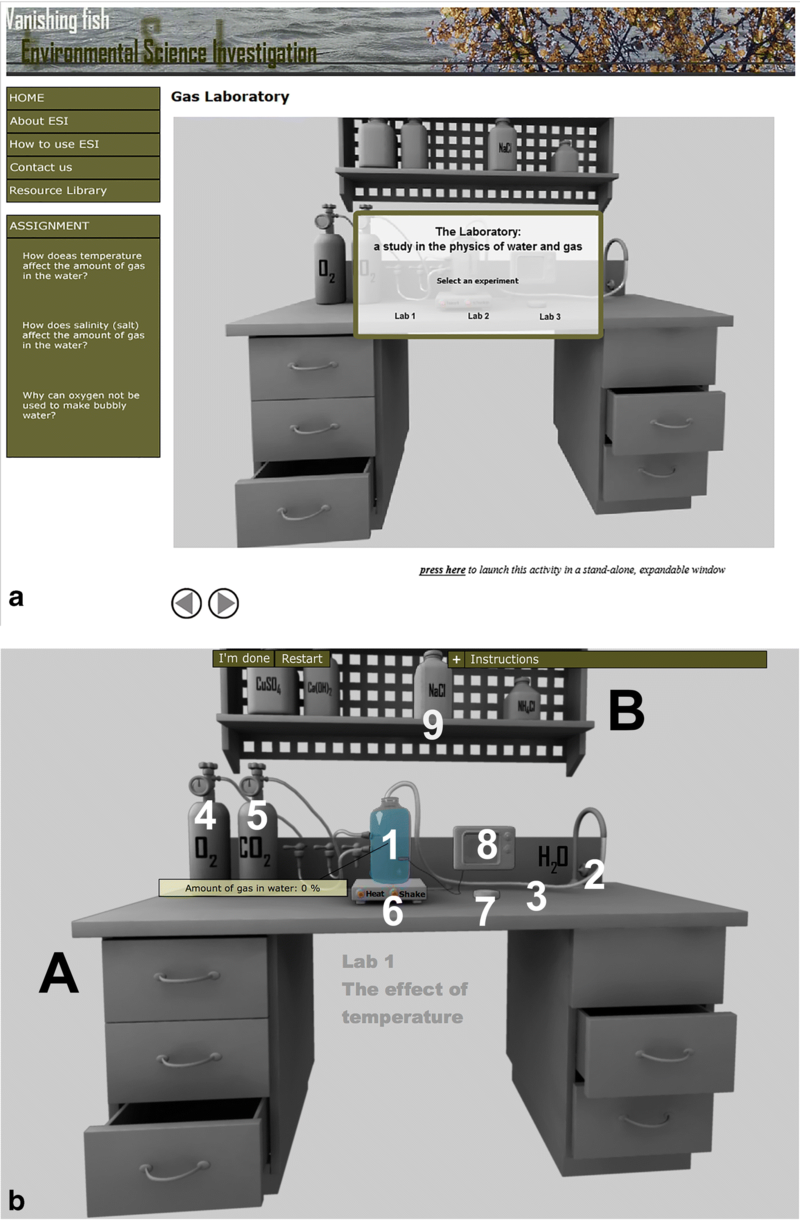
Unfortunately, the environment uses flash that is not longer available by default in web browsers.
Guiding
As also discussed in the guided discovery community, giving a "pure" simulation to a student is not very effective. Both researchers and practitioners agree that learners need some explicit or implicit guidance and scaffolding. The question is how and how much. “When used in class, simulations become part of an integrated system of resources that guide learning – including implicit guidance from the simulation, as well as explicit guidance from the written activity and the instructor (Hennessy et al., 2006; Lee et al., 2006; Chang et al., 2008; Khan, 2011). While much research has contributed to present knowledge of optimal design elements for interactive simulations (Lee et al.,2006; Adams et al., 2008b; Plasset al., 2009), less is known about how the amount, timing, and type of guidance affects students’ interaction, interpretation, and learning with these educational tools” (Chamberlain et al. (2014:628) [10] .
Perkins et al. (2012) [1] highlight the overarching importance and use of implicit scaffolding within sims. “Explicit scaffolding or guidance is ubiquitous in education. Within science instruction, an environment with significant explicit guidance can result in students merely following directions as opposed to engaging in sense- making and productive inquiry. Implicit scaffolding aims to retain a student’s sense of autonomy while creating an environment in which multiple, natural, investigative pathways and questions lead toward the desired knowledge acquisition. In short, implicit scaffolding guides without students feeling guided.”
Chamberlain et al. (2014:628) [10] compared three levels of guidance: heavy, medium and light. “Simulation features were characterized as “prompted” or “exploratory” based on the presence or absence of explicit guidance in the written activity to use that feature. While students in every condition were engaged with the simulation and their activity, student interaction with “exploratory” features decreased significantly when more guidance was provided (LG = 85%, MG = 68%, HG = 9%, p < 0.0005). Lighter guidance groups explored more and attended to their simulation interactions, indicated by a redraw task in the week after use. These results indicate that activity design – in terms of guidance level – can strongly influence student exploration with an interactive simulation.” In other words, if the learning goal includes to teach scientific reasoning, then there should not be too much external guidance, otherwise students will just follow instructions. The authors conclude that research should be more interested in the process by which students engage in simulations, because it will inform the design of the simulation itself but also of lesson plans and learning activities. Based on this research, Chamberlain et al. (2014:37) [10] make the following recommendation for teachers, but also leave the teachers the choice to use a more structure Guided discovery learning model.
Their key recommendation is to work with simulation environments that implement some form of implicit guidance, i.e. "affordable" tools that steer students to explore the simulation in meaningful directions.
Bibliography
Cited with footnotes
- ↑ 1.0 1.1 1.2 Perkins, K. K., Podolefsky, N. S., Lancaster, K., & Moore, E. B. (2012). Creating Effective Interactive Tools for Learning: Insights from the PhET Interactive Simulations Project. EdMedia + Innovate Learning, 2012(1), 436–441. Retrieved from https://www.learntechlib.org/p/40781/
- ↑ Rieber, L. P. (1996). Seriously considering play: Designing interactive learning environments based on the blending of microworlds, simulations, and games. Educational Technology Research & Development, 44(2), 43-58
- ↑ Hawkins, D. (1965) Messing about in science. The Informed Vision, Essays on Learning and Human Nature. Agathon Press 1974
- ↑ Norman, D. A. (1988). The Design of Everyday Things. Basic Books.
- ↑ Clark, R. C., & Mayer, R. E. (2007). e-Learning and the Science of Instruction: Proven Guidelines for Consumers and Designers of Multimedia Learning (2nd ed.). Pfeiffer.
- ↑ Wieman, C. E., & Perkins, K. K. (2006). A powerful tool for teaching science. Nature Physics, 2(5), 290–292. https://doi.org/10.1038/nphys283
- ↑ Podolefsky, N.S., Perkins, K.K. & Adams, W.K. (2010). Factors Promoting Engaged Exploration with Computer Simulations. (2), 20117. https://journals.aps.org/prper/abstract/10.1103/PhysRevSTPER.6.020117
- ↑ 8.0 8.1 8.2 8.3 8.4 Stahre Wästberg, B., Eriksson, T., Karlsson, G., Sunnerstam, M., Axelsson, M., & Billger, M. (2019). Design considerations for virtual laboratories: A comparative study of two virtual laboratories for learning about gas solubility and colour appearance. Education and Information Technologies, 24(3), 2059–2080. https://doi.org/10.1007/s10639-018-09857-0
- ↑ Ryan, T. A., & Schwartz, C. B. (1956). Speed of perception as a function of mode of representation. American Journal of Psychology, 69, 60–69.
- ↑ 10.0 10.1 10.2 Chamberlain, J. M., Lancaster, K., Parson, R., & Perkins, K. K. (2014). How guidance affects student engagement with an interactive simulation. Chemistry Education Research and Practice, 15(4), 628–638. https://doi.org/10.1039/c4rp00009a
Other
- Adams W. K., Reid S., LeMaster R., McKagan S. B., Perkins K. K.,Dubson M. and Wieman C. E., (2008a), A study of educationalsimulations part I – engagement and learning,J. Interact.Learn. Res.,19, 397–419.
- Adams W. K., Reid S., LeMaster R., McKagan S. B., Perkins K. K.,Dubson M. and Wieman C. E., (2008b), A study of educationalsimulations part II – interface design,J. Interact. Learn. Res.,19,551–577
- Chang K.-E., Chen Y.-L., Lin H.-Y. and Sung Y.-T., (2008), Effectsof learning support in simulation-based physics learning,Comput. Educ.,51, 1486–1498
- Hennessy S., Deaney R. and Ruthven K., (2006), Situatedexpertise in integrating use of multimedia simulation intosecondary science teaching,Int. J. Sci. Educ.,28(7), 701–732.
- Khan S., (2011), New pedagogies on teaching science withcomputer simulations,J. Sci. Educ. Technol.,20, 215–232.
- Lee H., Plass J. L. and Homer B. D., (2006), Optimizing cognitiveload for learning from computer-based science simulations,J. Educ. Psychol.,98(4), 902–913.


